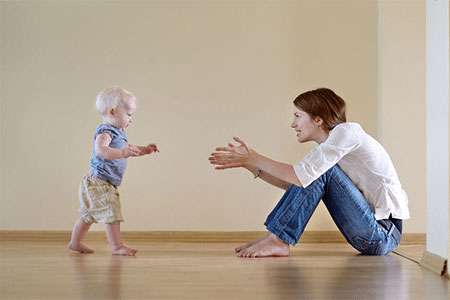What Shoes Help a Baby Walk? – Allow Your Baby to Take Those First Steps with Confidence!
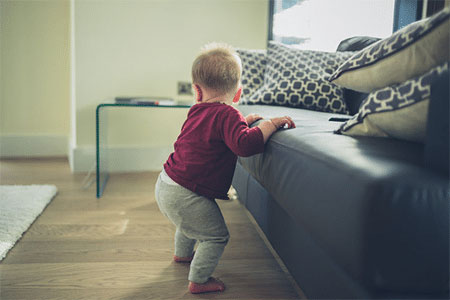
If your baby is cruising—shuffling side to side while holding onto furniture—it’s a sign they’re getting ready to walk independently. This exciting milestone usually happens between 8 and 11 months, and it’s the perfect time to start thinking about first walking shoes. While shoes won’t teach your baby to walk, the right pair can provide essential support, protection, and stability. Proper footwear helps maintain healthy foot and ankle alignment, enhances balance, and shields little feet from rough or dangerous surfaces—giving your baby the confidence to take those first steps safely.
About Baby Shoes – Things to Consider
Some first walking shoes stand out because they’re designed to support your baby’s natural development. Look for shoes with sensory pods on the soles—they help babies feel the ground beneath them, boosting stability and confidence with every step. It’s also essential to choose styles with a rounded toe box that gives toes room to wiggle freely, since toe movement plays a key role in helping babies strengthen and exercise their feet.
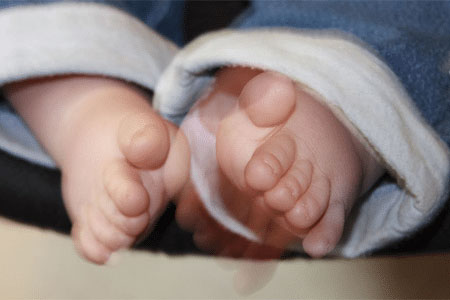
My Experience Fitting Baby Shoes
Having worked in a specialized children’s shoe store since 2013, I’ve had the pleasure of fitting countless babies for their first pair of walking shoes. My experience has taught me that every child’s foot is unique, and a personalized approach is key. Understanding the nuances of each child’s foot shape, size, and specific needs is essential for ensuring a proper fit that promotes healthy development.
Can Shoes Help Your Baby Walk?
The short answer is yes. While shoes alone won’t teach your baby to walk, the right ones can provide the support and protection needed during this crucial developmental phase. They offer stability and help protect your child’s feet from rough surfaces and sharp objects as they explore their surroundings.

When your baby is learning to walk, the main role of shoes is to protect their feet during outdoor play—at home, it’s best to let them go barefoot to promote healthy foot development. While shoes won’t speed up the walking process, the right fit is essential; shoes that are too long, too short, too stiff, or too heavy can throw off your baby’s balance, reduce stability, and make walking more difficult. Choose lightweight, flexible shoes that support your baby’s natural movement and growing confidence.
Key Features of First Walking Shoes for Babies
Selecting the right shoes involves more than just picking a cute design. Here are the features you should prioritize to ensure your child’s comfort and safety:
Feature One: Flexible Soles. The soles of baby walking shoes should be flexible to allow natural movement and development of the foot. This flexibility helps your baby balance and feel the ground beneath them, which is essential for learning to walk.

Feature Two: Sensory Pods. Your baby’s shoes should feature sensory pods on the soles to boost stability and confidence with every step. These pods enhance ground feel, helping your baby stay balanced and reducing the risk of slipping or falling as they learn to walk.
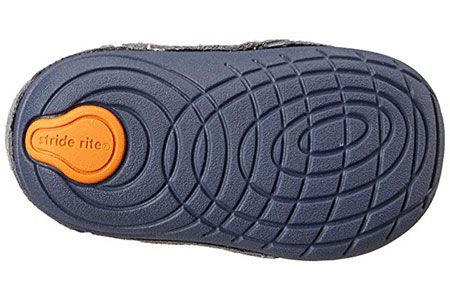
Feature Three: Rounded Soles. Flexible rounded soles encourage natural movement and improve balance. Babies are constantly wiggling their toes – which is nature’s way of exercising their feet for healthy foot development – and if you provide your baby with a shoe that is too narrow you will be constricting this movement.

Feature Four: Oversized Openings. Look for shoes with oversized openings, which make it easier to put the shoes on and take them off. This feature is especially beneficial for parents, as it reduces the struggle of dressing a wiggly toddler.
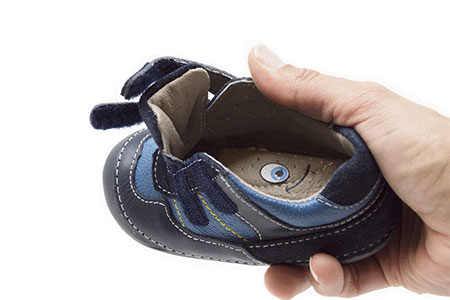
Feature Five: Breathable. Breathable materials are essential to keep your baby’s feet cool and dry, preventing discomfort and potential foot issues.
My top recommendations include shoes that offer a combination of flexible soles, sensory pods, and breathable materials. Disclosure: Some links may be affiliate links, meaning we earn a small commission at no extra cost to you.
Best First Walking Shoes for Babies for Better Balance
Discover the best first walking shoes for babies in 2025—available in medium (M), wide (W), and extra wide (XW) widths to ensure the perfect fit for your little one.
1. Shoe Style Stevie II by See Kai Run
These See Kai Run baby shoes are a popular choice among parents for its wide toe box and adjustable straps, making it an excellent option for kids with wide feet.
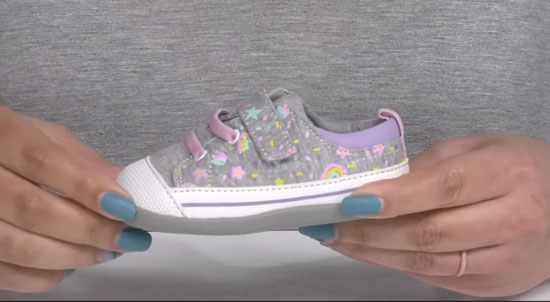
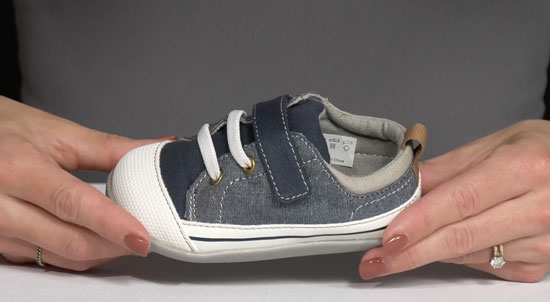
Key Features
- Order the shoe Stevie II by See Kai Run on Amazon or Zappos
- Not available in wide or extra wide widths but fits naturally wide
- Awarded the Seal of Acceptance from the American Podiatric Medical Association (APMA)
- Durable cotton drill upper, comfy leather insole, and recycled mesh lining keep feet fresh
- Breathable textile lining and cushioned insole
- I suggest that you get this shoe a whole size larger than your toddler’s current foot size
2. Shoe Style Thompson by Stride Rite
These baby first walking shoes feature a flexible sole and a rounded toe design to support natural movement, making them a favorite among parents and podiatrists alike.
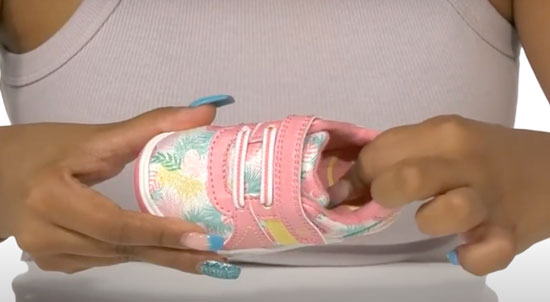
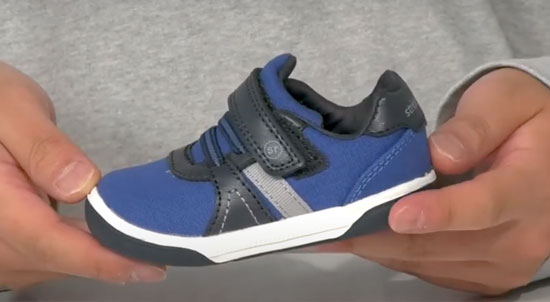
Key Features
- Order the shoe Thompson Sneaker on Amazon
- Available in wide widths
- Awarded the Seal of Acceptance from the American Podiatric Medical Association (APMA)
- Padded tongue and collar for added comfort
- Breathable textile lining and cushioned insole
- I suggest that you get this shoe a whole size larger than your toddler’s current foot size
3. Shoe Style Racer by Tsukihoshi
Tsukihoshi walking shoes for babies are lightweight, flexible, and capable of accommodating babies with wide feet and high insteps.

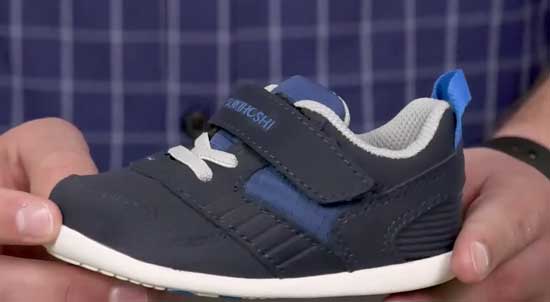
Key Features
- Order the shoe Artie and Adalyn by Stride Rite on Amazon or Zappos
- Rounded edges to decrease stumbles and falls
- Available in wide and extra wide widths
- I suggest that you get this shoe a whole size larger than your child’s current foot size
4. Shoe Style Artie and Adalyn by Stride Rite
These Stride Rite baby walking shoes provide excellent width options (wide and extra wide) and a comfortable fit. Their design includes flexible outsoles and cushioned insoles, which are essential for active toddlers.

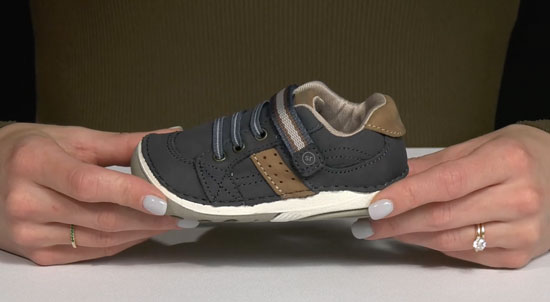
Key Features
- Order the shoe Artie and Adalyn by Stride Rite on Amazon or Zappos
- Rounded edges to decrease stumbles and falls
- Available in wide and extra wide widths
- I suggest that you get this shoe a whole size larger than your child’s current foot size
5. Shoe Style Elliott by Stride Rite
These Stride Rite booties for babies offer a stable base of support and a comfortable fit, making them a top choice for babies with wide feet.
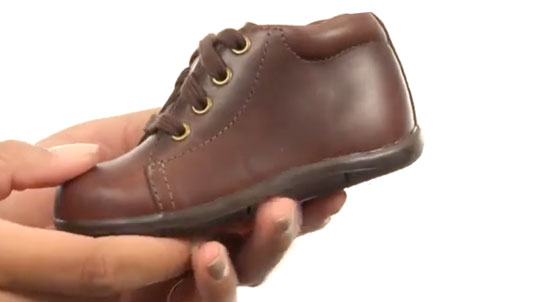
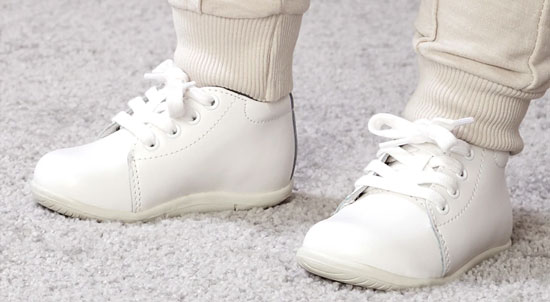
Key Features
- Order the shoe SRT Elliot by Stride Rite on Amazon or Zappos
- Available in wide and extra wide widths
- 100% leather made
- I suggest getting this shoe a whole size larger than your toddler’s current foot size
6. Shoe style Archie and Kiki by Stride Rite
These baby sandals are crafted to provide maximum comfort for wide feet. With their breathable materials and secure fit, they offer the support and flexibility needed for a growing child.
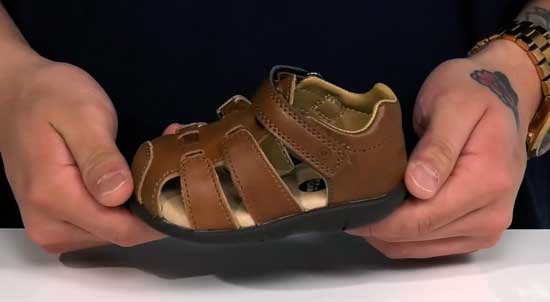
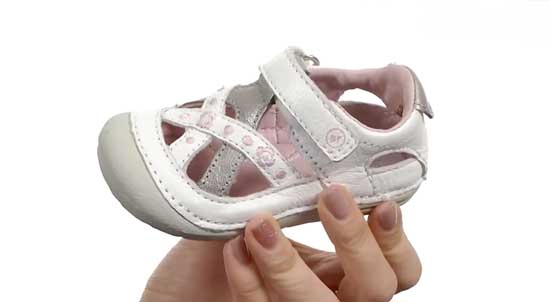
Key Features
- Order the shoe Archie and Kiki on Amazon or Zappos
- Available in wide and extra wide widths
- Leather upper
- Foam padding placed around the ankle collar and under the tongue for a comfortable fit
- I suggest that you get this shoe a half size larger than your toddler’s current foot size
7. Shoe Style Martin by Stride Rite
These baby shoes feature a wide toe box and plush cushioning, making it perfect for everyday wear.
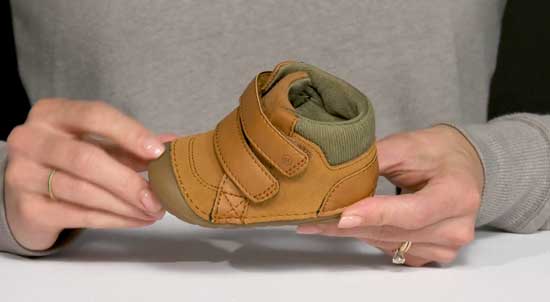
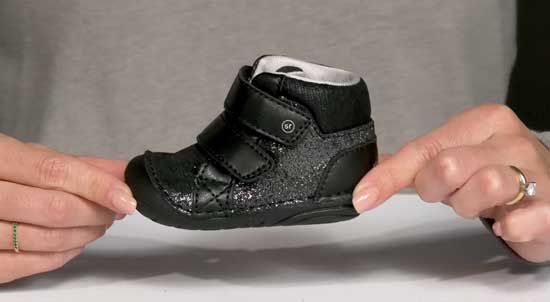
Key Features
- Order the shoe Martin by Stride Rite on Zappos
- Available in wide and extra wide widths
- I suggest that you get this shoe a whole size larger than your toddler’s current foot size
8. Shoe Style Casey by See Kai Run
These See Kai Run booties provide extra depth, rounded toe-boxes, and opens up nice and wide for easy on and off.
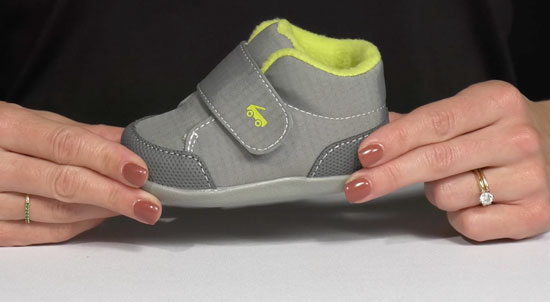
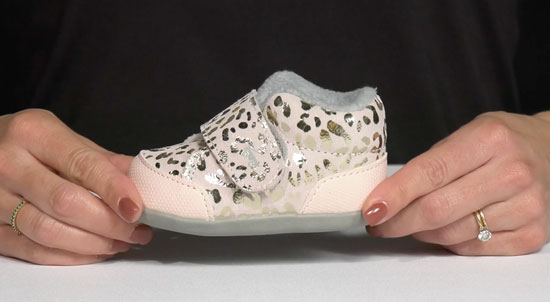
Key Features
- Order the shoe Casey by See Kai Run on Amazon or Zappos
- Not available in wide or extra wide widths but fits naturally wide
- Awarded the Seal of Acceptance from the American Podiatric Medical Association (APMA)
- Fleece lining for extra warmth
- I suggest that you get this shoe a whole size larger than your toddler’s current foot size
9. Shoe Style Lucia by See Kai Run
These baby girl Mary Jane shoes feature a roomy toe box, flexible sole, and breathable materials to support healthy foot development and all-day comfort for early walkers.
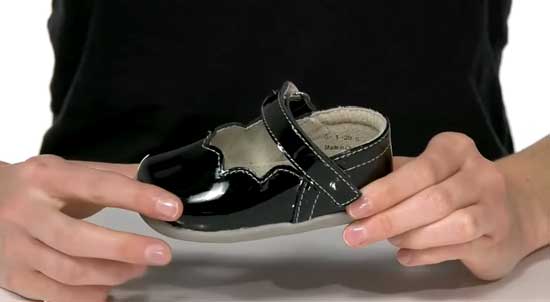
Key Features
- Order the shoe Casey by See Kai Run on Amazon or Zappos
- Not available in wide or extra wide widths but fits naturally wide
- Awarded the Seal of Acceptance from the American Podiatric Medical Association (APMA)
- Fleece lining for extra warmth
- I suggest that you get this shoe a whole size larger than your toddler’s current foot size
10. Merrell Kids’ Bare Steps Sneaker
These Merrell shoes that help babies walk are designed with a wide toe box and a barefoot feel, encouraging natural foot development.
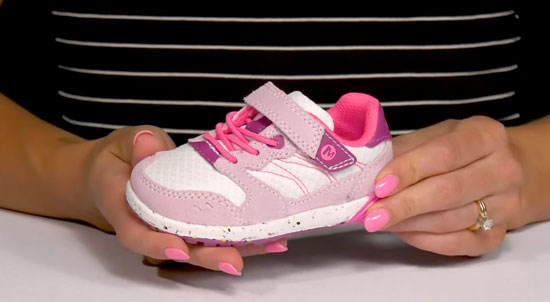
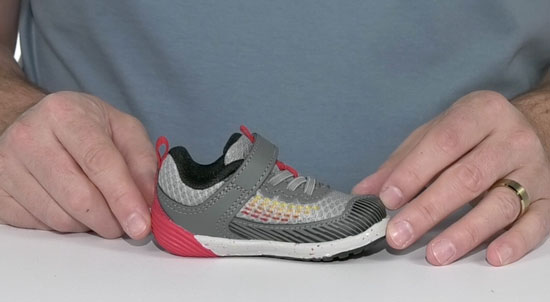
Key Features
- Order the shoe Bare Steps by Merrell on Amazon or Zappos
- Not available in wide or extra wide widths but fits naturally wide
- Awarded the Seal of Acceptance from the American Podiatric Medical Association (APMA)
- Padded tongue and collar for added comfort
- I suggest that you get this shoe a whole size larger than your toddler’s current foot size
I specifically picked these shoe styles because they offer the roundest toe-boxes and extra depth—key features that give your baby’s feet the room to wiggle and grow strong, promoting healthy foot development every step of the way.
Can You Buy Baby Shoes Based on Age?
While it’s possible to buy baby shoes based on age, it’s not recommended. Each child’s foot grows at a different rate, and age-based sizing can lead to ill-fitting shoes that hinder development. It’s always best to measure your child’s feet and choose shoes that fit correctly. Ill-fitting shoes can cause discomfort, restrict movement, and potentially lead to developmental issues. Furthermore, relying solely on age for sizing does not account for individual variations in foot shape and size.
I created a general guide to find out your baby’s shoe size by age:
- 0-3 months: Size 1
- 3-6 months: Size 2
- 6-9 months: Size 2.5, 3
- 9-12 months: Size 3.5, 4
- 12-18 months: Size 4.5, 5
- 18-24 months: Size 5.5, 6
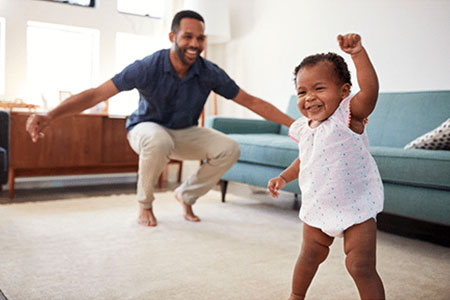
How to Find Your Baby’s Exact Foot Size
Choosing the right shoe size is crucial—not only to support your baby’s walking progress but also to prevent foot issues like blisters and calluses. I offer a virtual shoe fitting service that helps you measure your child’s exact foot size and width—narrow, medium, wide, or extra wide—and identify if they have a high instep, all from the comfort of your home.
Best Socks for Babies – Seamless and Breathable
When it comes to pairing socks with shoes, the focus should be on breathability and a seamless design. Breathable, seamless socks give your baby the freedom to wiggle their toes comfortably and help prevent irritation, making them the best choice for all-day wear.
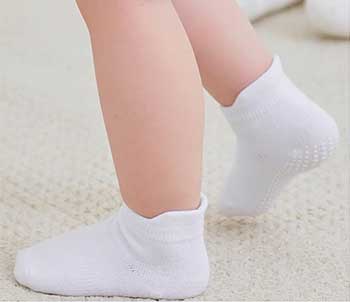
- Order these socks made by Zaples on Amazon
- Strong grips at the bottom cover the whole foot from heel to toe
- The pull tabs behind the ankle help the mom to put on and take off the socks very easily
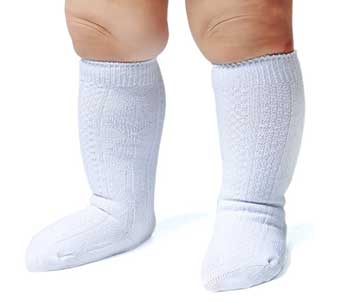
- Order these socks made by Epeius on Amazon
- 76% combed cotton, 21% polyester and 3% spandex
- Seamless cable/ribbed knit knee high socks for babies
- Breathable
- Machine wash
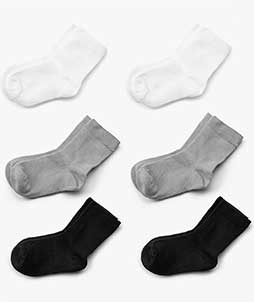
- Order these socks made by SilkyToes on Amazon
- 80% Rayon from Bamboo, 10% Polyester, 5% Nylon, 5% Spandex
- Cushioned sole to keep your child’s feet comfortable
- Machine wash
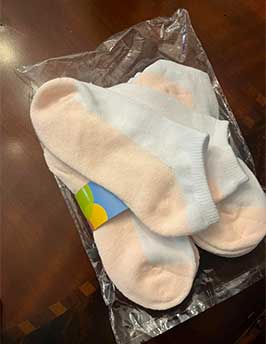
- Order these socks made by Jefferies on Amazon
- Smooth toe seam provides less irritation and bulk for sensitive toes and feet
- Made with premium ultra soft cotton
- Quarter ribbed stay-up top is extra comfortable around the ankles
Reach Out for Personalized Shoe Recommendations
I offer personalized shoe recommendations based on your baby’s foot shape and condition. Whether your child has wide feet, narrow feet, or specific foot conditions, I can guide you to the best options available. By understanding the unique characteristics of your child’s feet, I can recommend shoes that provide the optimal combination of support, comfort, and style. Don’t hesitate to reach out for expert advice and find the perfect pair of shoes that will support your child’s walking journey.

